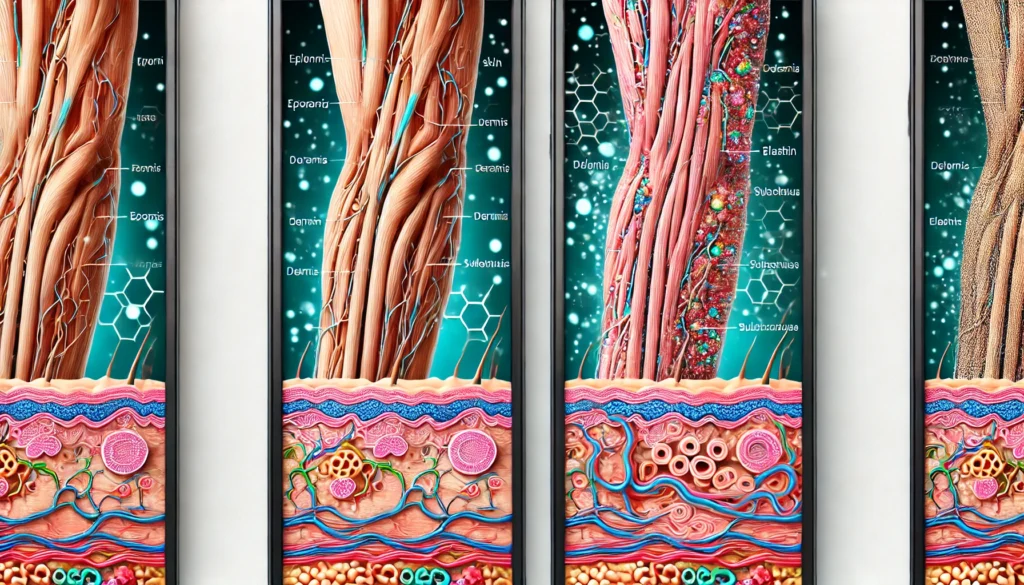For many people, achieving significant weight loss is a major health milestone that brings numerous physical and emotional benefits. However, one of the most commonly overlooked consequences of rapid or substantial weight loss is the appearance of loose arm skin. Often described as “bat wings,” this sagging skin can cause aesthetic concerns and impact self-confidence, even after reaching a healthy weight. Understanding how to tighten saggy arm skin after weight loss requires a comprehensive, medically informed approach that includes non-invasive treatments, surgical options, and natural strategies supported by evidence-based wellness practices.
You may also like: How to Tighten Loose Skin After Weight Loss: Science-Backed Strategies for a Firmer, Healthier You

Understanding the Causes of Sagging Arm Skin
Loose arm skin following weight loss is primarily due to the loss of fat that previously stretched the skin taut. When fat is lost quickly or in large amounts, the skin does not always have time or elasticity to retract. This is particularly true for individuals who have experienced obesity for many years, during which time the skin may have permanently stretched and weakened. Collagen and elastin—proteins responsible for skin’s firmness and flexibility—degrade with age, making sagging more pronounced in older adults. Additionally, genetic factors, hydration levels, sun exposure, and smoking history all play roles in determining how the skin responds after weight reduction.
Understanding this biological background is essential when exploring how to tighten loose skin on arms naturally or through more advanced interventions. Whether someone is dealing with mild sagging or considering arm flab surgery, knowing the root causes provides clarity and realistic expectations about what each treatment can accomplish.
Non-Surgical Arm Tightening Treatments
For those hesitant to pursue surgery, several non-invasive and minimally invasive treatments can help stimulate collagen production and improve skin elasticity. One of the most widely recommended options is radiofrequency therapy, a technique that uses energy waves to heat the deep layers of the skin, promoting collagen remodeling. These sessions are usually painless, require no downtime, and offer gradual but noticeable improvement in arm skin tightening.
Another popular choice is ultrasound therapy, such as Ultherapy, which targets deeper skin tissues without damaging the surface. This treatment triggers the body’s natural healing response, leading to firmer, smoother skin over time. Laser therapies, especially fractional lasers, have also shown efficacy in treating sagging arm skin by creating micro-injuries that stimulate collagen regeneration.
Cryolipolysis, commonly known as CoolSculpting, can complement these methods by targeting residual arm fat, helping to contour the area while tightening the overlying skin. Although results from these arm tightening treatments may not be as dramatic as surgical procedures, they are appealing for individuals seeking gradual improvement with minimal risk and downtime.

The Role of Exercise in Arm Skin Tightening
While exercise cannot eliminate sagging arm skin entirely, it plays a critical role in improving underlying muscle tone and enhancing the overall appearance of the arms. Targeted strength training routines, particularly those focusing on the triceps, biceps, and shoulders, can help fill out some of the loose areas, giving the arms a firmer, more sculpted look. Movements like tricep dips, push-ups, bicep curls, and resistance band exercises are especially effective.
However, it’s important to understand that exercise alone cannot remove excess skin. This distinction is vital when managing expectations about how to tighten arm skin without surgery. Consistent resistance training combined with cardiovascular activity supports skin health by boosting circulation and encouraging lymphatic drainage, both of which aid in nutrient delivery and waste removal at the cellular level.
Adding flexibility exercises such as yoga or Pilates can also contribute to better posture and muscle alignment, which indirectly enhances the appearance of the arms. While not a standalone solution, exercise is an essential component of a holistic approach to arm tightening, particularly when used in combination with dietary changes and topical support.
Nutritional Strategies for Healthier Skin Elasticity
The health of your skin is intimately tied to what you consume. Diets rich in vitamins, antioxidants, and hydration can significantly affect the skin’s ability to repair itself and remain resilient. When learning how to tighten saggy arm skin after weight loss, one must consider the role of key nutrients such as vitamin C, which supports collagen synthesis, and vitamin E, a powerful antioxidant that helps protect against oxidative stress.
Protein is another foundational element in skin repair and regeneration. Amino acids found in lean meats, fish, legumes, and dairy are critical building blocks for collagen and elastin. Omega-3 fatty acids from sources like flaxseed, walnuts, and salmon provide anti-inflammatory benefits that can soothe skin and improve overall tone. Zinc, selenium, and hyaluronic acid also play important roles in maintaining skin moisture and cellular turnover.
Hydration is equally vital. Drinking adequate water daily helps preserve skin plumpness and elasticity, while reducing the appearance of wrinkling or sagging. Herbal teas rich in polyphenols, such as green tea or rooibos, offer additional skin-supportive benefits. When paired with regular exercise and non-invasive therapies, dietary changes can help you tighten arms after weight loss from the inside out.
Topical Treatments and Skin Care Protocols
Topical treatments can enhance the skin’s appearance when chosen carefully and used consistently. Products containing retinoids, such as retinol or tretinoin, help increase cell turnover and stimulate collagen production, which is essential in arm skin tightening. These compounds are often used in facial skincare but are equally effective on the body, including the upper arms.
Firming creams with peptides, hyaluronic acid, and vitamin C can offer additional benefits by hydrating the skin and providing antioxidant protection. Caffeine-based creams may temporarily reduce the appearance of saggy arm skin by increasing circulation and tightening tissue. However, while these products can be helpful adjuncts, they are not miracle cures and should be used in conjunction with other strategies for meaningful improvement.
Exfoliation also plays a key role in skin rejuvenation. Gentle physical or chemical exfoliants can remove dead skin cells and encourage new skin growth, making the arms look smoother and more toned. Applying moisturizers immediately after exfoliation helps seal in hydration and improves the skin’s overall texture. Used wisely, topical treatments are a supportive component of broader sagging arms treatment plans.

Surgical Options for Arm Skin Removal
When natural and non-invasive strategies are insufficient, surgical intervention may be the most effective route. The most well-known procedure for removing excess upper arm skin is brachioplasty, commonly referred to as an arm lift. So, what is a brachioplasty? It is a surgical procedure that removes loose skin and fat from the underarm area, tightening and reshaping the arm’s contour.
Brachioplasty is typically performed under general anesthesia and involves making an incision from the elbow to the armpit. While this procedure offers dramatic and immediate results, it also comes with scarring, a recovery period, and the risks inherent to any surgical operation. Despite these drawbacks, for individuals dealing with severe sagging arms after weight loss, the benefits often outweigh the costs.
In some cases, arm fat removal surgery may be performed in conjunction with brachioplasty. Liposuction is used to extract residual fat before the skin is tightened, creating a more defined appearance. This combination approach is common in flabby arm surgery and is tailored to the patient’s specific anatomy and cosmetic goals. It’s crucial to consult a board-certified plastic surgeon with experience in post-weight loss body contouring to determine whether this route is appropriate.
The Psychological Impact of Saggy Arm Skin
Body image plays a central role in mental well-being, and dealing with sagging underarm skin can significantly affect self-esteem. Many individuals find that despite achieving a healthier weight, they still feel insecure due to persistent loose arm skin. This disconnect between physical health and body confidence can contribute to anxiety, depression, or even disordered eating behaviors as individuals struggle to reconcile their external appearance with their internal goals.
Understanding how to get rid of arm flab after losing weight is not just a cosmetic issue—it’s a mental health concern as well. Support from therapists, body image specialists, and peer communities can help individuals navigate this complex emotional terrain. Reassurance, realistic expectations, and compassionate self-talk are crucial components of any treatment plan aimed at addressing saggy arm skin.
As part of a comprehensive mental health strategy, incorporating mindfulness practices, journaling, and cognitive behavioral techniques can help manage negative self-talk and foster greater acceptance. While surgical or non-surgical treatments address the physical aspects, psychological resilience ensures lasting well-being during and after the transformation process.

Combining Strategies for Sustainable Results
The most effective approach to managing flabby skin on arms involves combining multiple interventions in a thoughtful, personalized manner. For some, this might mean pairing strength training and dietary changes with occasional skin-tightening treatments like radiofrequency or laser therapy. For others, it may involve preparing for flabby arm surgery while simultaneously practicing mental health support techniques to manage expectations and promote self-compassion.
Timing and consistency are key. Skin remodeling is a gradual process, and even the most advanced treatments require weeks or months to show results. Patience, paired with evidence-based decision-making, yields the best outcomes. If surgery becomes necessary, patients should view it as one piece of a larger journey toward physical and emotional well-being, not a quick fix.
Working with a dermatologist, plastic surgeon, nutritionist, and mental health professional provides a collaborative model that ensures every dimension of arm tightening is addressed. This holistic, team-based strategy honors the complexity of post-weight loss transformation and helps individuals feel supported and empowered throughout their journey.
Evaluating Risks and Setting Realistic Expectations
Any attempt to improve the appearance of sagging arm skin must be grounded in realistic expectations. No treatment, surgical or otherwise, can completely restore youthful skin elasticity, especially after dramatic weight loss. However, many individuals experience profound improvements through well-selected interventions. Understanding the limitations and potential complications of each method is crucial in making informed choices.
Surgical risks may include infection, scarring, and poor wound healing, especially in individuals with comorbidities like diabetes or cardiovascular disease. Non-invasive options may offer subtler results and require repeated treatments, but they carry fewer risks and less downtime. It’s important to weigh these trade-offs and discuss them thoroughly with qualified healthcare providers.
Moreover, financial costs can vary significantly. Insurance rarely covers procedures considered cosmetic, such as brachioplasty or arm fat removal surgery. Budgeting for these interventions and understanding the long-term investment involved in maintenance is essential for sustainable success. Consulting with multiple professionals and reading reviews or case studies can provide a clearer picture of likely outcomes.
Creating a Personalized Plan for Arm Skin Tightening
There is no one-size-fits-all solution for sagging arm skin. The optimal strategy depends on factors such as the extent of skin laxity, overall health status, age, skin type, and personal goals. While one individual might benefit from intensive arm tightening treatments like microneedling combined with hyaluronic acid, another might find that a structured exercise program and medical-grade topical creams offer sufficient improvement.
Consultations with medical professionals help tailor these options to your specific needs. Tools such as 3D imaging and elasticity testing can assess the skin’s responsiveness and predict potential outcomes. By establishing short-term goals and long-term maintenance strategies, individuals can approach this issue with clarity and confidence.
Importantly, recognizing the emotional impact of saggy arm skin and building a support system—whether through therapy, community groups, or online forums—helps sustain motivation and emotional resilience. Ultimately, a personalized plan ensures that each step taken toward tighter, healthier arms is informed, deliberate, and aligned with broader health and wellness values.
Frequently Asked Questions: How to Tighten Saggy Arm Skin After Weight Loss
1. Can collagen supplements help with arm skin tightening after major weight loss?
Yes, collagen supplements may support arm skin tightening by providing the essential amino acids needed to rebuild skin structure, especially after weight loss. Although oral collagen peptides are not a substitute for professional arm tightening treatments, emerging studies suggest they can improve skin elasticity and hydration when taken consistently over several months. For people with loose arm skin or sagging underarm skin, supplements may be used alongside topical treatments and resistance training to amplify results. However, individual responses vary, and age, baseline collagen levels, and lifestyle habits can influence efficacy. Always choose clinically tested supplements with transparent ingredient sourcing to ensure safety and effectiveness.
2. How does hormonal health influence sagging arm skin and treatment outcomes?
Hormonal balance plays a surprisingly significant role in how skin responds to interventions for saggy arm skin. Estrogen, for example, is involved in collagen synthesis, and its decline during perimenopause or menopause can accelerate skin laxity, making sagging arms after weight loss more difficult to treat. Similarly, cortisol, the stress hormone, can disrupt tissue repair and collagen turnover, affecting how well arm tightening strategies work. If a person’s hormone levels are imbalanced, even the best arm skin removal or non-surgical therapies may yield slower progress. Consulting an endocrinologist or integrative physician may uncover hidden contributors to persistent sagging arm skin and inform a more tailored treatment plan.
3. What lifestyle habits can sabotage efforts to tighten arm skin?
Several daily habits may inadvertently interfere with how to tighten saggy arm skin effectively. Chronic dehydration, poor sleep, and smoking can all compromise collagen regeneration, which is crucial for arm skin tightening. High sugar intake can also promote glycation, a process that stiffens collagen fibers, leading to further sagging. Even frequent sun exposure without protection breaks down elastin, particularly on thinner areas like the upper arms. When aiming to get rid of flabby skin on arms, holistic care is vital—healthy lifestyle choices can significantly improve both surgical and non-surgical outcomes.
4. How does skin type and ethnicity affect sagging arms treatment options?
Different skin types and ethnic backgrounds can influence how the skin responds to arm tightening treatments. Individuals with darker skin tones may be more prone to hyperpigmentation or scarring from invasive procedures like arm flab surgery or laser therapy. On the other hand, thicker or oilier skin may be more resilient to sagging but slower to tighten through non-invasive options. Understanding these differences is critical when exploring how to get rid of saggy arms after weight loss. A dermatologist experienced in treating diverse skin types can provide customized recommendations that minimize risks while maximizing results.
5. Are there advanced arm tightening treatments that go beyond common methods?
Yes, emerging technologies now offer sophisticated solutions for those seeking alternatives to traditional arm flab surgery. Treatments like radiofrequency microneedling, which combines heat and controlled skin injury, can stimulate collagen more deeply than surface-level treatments. High-intensity focused ultrasound (HIFU) is another innovation used to treat sagging underarm skin without incisions or downtime. These modalities may be more suitable for individuals hesitant about arm fat removal surgery or those with only mild to moderate sagging. For anyone wondering how to tone loose skin on arms with the latest options, a consultation with a med spa or aesthetic clinic specializing in skin rejuvenation is a good first step.
6. What is the emotional impact of having flabby skin on arms post-weight loss?
While flabby arm skin is often treated as a cosmetic issue, its psychological toll can be profound. Many people who have successfully lost weight still feel insecure due to persistent sagging arm skin, undermining their body image and emotional well-being. Social anxiety, avoidance of sleeveless clothing, and reluctance to exercise in public are common experiences. Understanding what to do about sagging arms requires a compassionate approach that includes psychological support, especially for those struggling with self-esteem. Therapy or support groups focused on body positivity can help reframe the narrative and reinforce that seeking treatment for arm skin issues is a form of self-care, not vanity.
7. Is there a difference between arm fat removal surgery and brachioplasty?
Yes, while the terms are sometimes used interchangeably, there are key differences. Arm fat removal surgery typically refers to liposuction, which removes excess fat from the upper arms but does not address loose or sagging skin. Brachioplasty, the surgery name for arm lift procedures, involves both fat removal and skin excision, making it the more comprehensive solution for advanced saggy arm skin. In some cases, both techniques are combined to create optimal arm contouring. Patients considering flabby arm surgery should discuss their specific needs with a plastic surgeon to determine whether liposuction alone or full arm skin removal is necessary.
8. Can body composition changes over time affect results from arm tightening procedures?
Absolutely—significant changes in body composition post-treatment can influence the long-term success of arm tightening procedures. For example, gaining substantial weight after a successful arm skin tightening regimen may stretch the skin again, leading to recurring sagging. Conversely, further fat loss without muscle building could worsen the appearance of flabby skin on arms. To sustain results from treatments like arm flab surgery or non-surgical tightening, a focus on long-term fitness, including muscle preservation, is essential. Clients should prioritize strength training and maintain a stable, healthy weight to protect their investment in sagging arms treatment.
9. What are some lesser-known topical ingredients that help with arm tightening?
Beyond mainstream ingredients like retinol and hyaluronic acid, certain lesser-known actives are gaining attention for their ability to tighten arm skin. Ingredients such as DMAE (dimethylaminoethanol), which has firming properties, and copper peptides, known for promoting skin repair, can be effective additions to topical regimens. Additionally, botanical extracts like centella asiatica and echinacea may boost microcirculation and collagen integrity, particularly in sagging underarm skin. While not as powerful as medical treatments or flabby arm surgery, consistent topical care can support overall skin quality and enhance results from other interventions. Look for multi-ingredient formulas backed by clinical trials when selecting products.
10. How do you determine if natural strategies alone are enough to tighten arm skin?
Deciding whether natural methods will suffice depends on the severity of the sagging, age, and skin health. Individuals with mild to moderate loose arm skin, especially younger adults, may see noticeable improvement from lifestyle changes, strength training, and skincare alone. Those seeking how to tighten arms after weight loss should observe progress over a three- to six-month period before considering more intensive treatments. However, if sagging arm skin severely impacts quality of life or remains unresponsive, surgical evaluation may be appropriate. The key is to set realistic expectations, track changes objectively, and stay consistent with natural approaches before escalating to clinical options.
Final Thoughts on How to Get Rid of Saggy Arms After Weight Loss
Navigating the journey of how to tighten saggy arm skin after weight loss involves more than just cosmetic desire—it reflects a deep commitment to personal health, body confidence, and holistic well-being. Whether through non-invasive therapies, medical-grade skincare, flabby arm surgery, or supportive lifestyle changes, there are multiple avenues to address loose skin in the arms. The key lies in blending evidence-based approaches with realistic expectations and a strong support system.
For those who have lost significant weight, dealing with sagging arms after weight loss is not a setback but an opportunity to complete their transformation. Understanding what a brachioplasty entails, exploring how to tighten underarm skin naturally, and selecting arm tightening treatments that align with one’s goals are all part of creating a sustainable wellness path. With the right guidance, compassion, and persistence, anyone can find a solution that works not just for their body, but for their sense of self.
This journey—rooted in medical science, enriched by personal insight, and supported by expert care—is not just about how to get rid of flabby skin on arms. It’s about reclaiming agency over your body and embracing the strength that comes with transformative change.
Was this article helpful? Don’t let it stop with you. Share it right now with someone who needs to see it—whether it’s a friend, a colleague, or your whole network. And if staying ahead on this topic matters to you, subscribe to this publication for the most up-to-date information. You’ll get the latest insights delivered straight to you—no searching, no missing out
Further Reading:
Tips for How to Tighten Loose Skin
Many ways to firm sagging skin
How can people firm up saggy skin?
Disclaimer
The information contained in this article is provided for general informational purposes only and is not intended to serve as medical, legal, or professional advice. While Health11News strives to present accurate, up-to-date, and reliable content, no warranty or guarantee, expressed or implied, is made regarding the completeness, accuracy, or adequacy of the information provided. Readers are strongly advised to seek the guidance of a qualified healthcare provider or other relevant professionals before acting on any information contained in this article. Health11News, its authors, editors, and contributors expressly disclaim any liability for any damages, losses, or consequences arising directly or indirectly from the use, interpretation, or reliance on any information presented herein. The views and opinions expressed in this article are those of the author(s) and do not necessarily reflect the official policies or positions of Health11News.